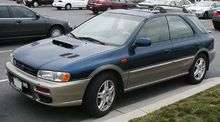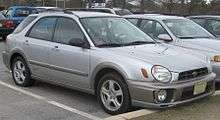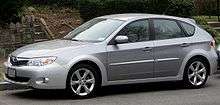Subaru Outback
| Wikimedia Commons has media related to Subaru Outback. |
The Subaru Outback is an automotive nameplate used by the Japanese automobile manufacturer Fuji Heavy Industries (FHI) since 1994. The "Outback" name has been utilized on two different Subaru branded vehicles. One of these models is based on the mid-sized Subaru Legacy and the other derived from the hatchback version of the Subaru Impreza. Named after the vast, remote, and arid outback regions in Australia—the name is intended to emphasize the moderate off-road capability of the vehicle.
Outback (1994–present)
The Outback station wagon debuted in the United States market in 1994 for the 1995 model year as a derivative of the second generation Subaru Legacy. In Japan, Subaru introduced this vehicle as the Legacy Grand Wagon in 1995, but in most other markets, this model became known as the Legacy Outback. In Australia, Subaru opted to shorten the name to Subaru Outback when launched there in 1996—thus becoming the first market to utilize the abbreviated name. Subaru developed the Outback by adding side body cladding and raising the suspension of the existing Legacy wagon. With the exception of small differences in trim, the Outback shared almost all of its components with the Legacy donor model. In the United States, Subaru retailed the Legacy SUS—a similar concept to the Outback, but based on the sedan body variant.
Subaru released a new generation of Outback along with an equivalent Legacy in 1998—or 1999 in North America for model year 2000. This Outback received the Legacy Lancaster name in Japan. Following much the same formula as the original, the updated series shared similar mechanics and dimensions, but with the abbreviated Subaru Outback title now specified for most markets outside Europe and Japan. For the first time, an Outback sedan joined the wagon for North America only.
In 2003, Subaru released another redesign of the Outback alongside the new Legacy. This series was delayed in North America until January 2004 for the 2005 model year. Like the two previous generations, the 2003 update followed much the same blueprint as before. This also included an Outback sedan in North America, only to be discontinued mid-way through this generation's lifespan. By adopting the Legacy Outback nameplate as used in Europe, these 2003 onwards models also marked the cessation of Subaru's eschewal of the Outback identity for Japan.
The 2009 iteration debuted in conjunction with the corresponding Legacy model, marketed as 2010 model year vehicles in North America. For this series, European markets now adopt the shortened Subaru Outback name.
The Outback was replaced worldwide in 2014 for the 2015 year model with the fifth generation, still badged the Legacy Outback for Japan. Notably, the 2014 model marked a change in marketing strategy for Subaru—the Legacy became sedan only—and the Outback as a wagon only, thus bringing greater product differentiation between the two model lines. The two vehicles remain fundamentally related with differences limited to the change in body style, ground clearance, and trim. The Legacy wagon was replaced by the Subaru Levorg in 2014.
_Special_Edition_station_wagon_(2010-09-23)_01.jpg) 1994–1998Main article: Subaru Legacy
1994–1998Main article: Subaru Legacy_H6_station_wagon_(2011-03-10)_01.jpg) 1998–2003Main article: Subaru Legacy
1998–2003Main article: Subaru Legacy 2003–2009Main article: Subaru Legacy
2003–2009Main article: Subaru Legacy_2.5i_station_wagon_(2015-07-14)_01.jpg) 2009–2014Main article: Subaru Legacy
2009–2014Main article: Subaru Legacy.jpg) 2014–presentMain article: Subaru Legacy
2014–presentMain article: Subaru Legacy
Outback Sport (1994–2011)
Along with the Legacy-based model, Subaru also released the Outback Sport in 1994 to North America only for the 1995 model year. Deriving from the first generation Subaru Impreza hatchback, the Outback Sport featured an off-road appearance package, and a slightly raised suspension akin to the larger Legacy-based model. Subaru in North America launched subsequent generations in 2001 for the 2002 model year and 2007 for model year 2008, based on the second and third generation Impreza, respectively. Subaru discontinued the Outback Sport nameplate in 2011, replaced in 2012 for the 2013 year model with the Subaru XV as derived from the fourth generation model.
 1994–2001Main article: Subaru Impreza
1994–2001Main article: Subaru Impreza 2001–2007Main article: Subaru Impreza
2001–2007Main article: Subaru Impreza 2007–2011Main article: Subaru Impreza
2007–2011Main article: Subaru Impreza
| « previous — Subaru, a division of Fuji Heavy Industries, vehicle timeline, 1990s–present | |||||||||||||||||||||||||||
|---|---|---|---|---|---|---|---|---|---|---|---|---|---|---|---|---|---|---|---|---|---|---|---|---|---|---|---|
| Type | 1990s | 2000s | 2010s | ||||||||||||||||||||||||
| 0 | 1 | 2 | 3 | 4 | 5 | 6 | 7 | 8 | 9 | 0 | 1 | 2 | 3 | 4 | 5 | 6 | 7 | 8 | 9 | 0 | 1 | 2 | 3 | 4 | 5 | 6 | |
| Kei car | Rex | Vivio | Pleo I | Pleo II (rebadged Daihatsu Mira) | |||||||||||||||||||||||
| R1 | |||||||||||||||||||||||||||
| R2 | Lucra (rebadged Daihatsu Tanto Ex) | ||||||||||||||||||||||||||
| Stella I | Stella II (rebadged Daihatsu Move) | ||||||||||||||||||||||||||
| Microvan | Sambar / Domingo | Sambar | Dias Wagon | ||||||||||||||||||||||||
| Subcompact | Justy I | Justy II | Justy III | Justy IV | Trezia | Justy V | |||||||||||||||||||||
| Dex | |||||||||||||||||||||||||||
| Compact | Leone III | Leone IV | Leone V | ||||||||||||||||||||||||
| Impreza I | Impreza II | Impreza III | Impreza IV | ||||||||||||||||||||||||
| Legacy I | |||||||||||||||||||||||||||
| Mid-size | Legacy II | Legacy III | Legacy IV | Legacy V | Legacy VI | ||||||||||||||||||||||
| Levorg | |||||||||||||||||||||||||||
| Sports coupé | Alcyone XT | Alcyone SVX | BRZ | ||||||||||||||||||||||||
| Compact MPV | Traviq | Exiga | |||||||||||||||||||||||||
| Crossover/SUV | XV | ||||||||||||||||||||||||||
| Outback I | Outback II | Outback III | Outback IV | Outback V | |||||||||||||||||||||||
| Bighorn | Bighorn | Forester I | Forester II | Forester III | Forester IV | ||||||||||||||||||||||
| Tribeca | |||||||||||||||||||||||||||
| Coupé utility | BRAT | Baja | |||||||||||||||||||||||||
| Current | |||||||||||||||||||||||||||
| Engines | |||||||||||||||||||||||||||
| Historic | |||||||||||||||||||||||||||
| Concept |
| ||||||||||||||||||||||||||
| Related | |||||||||||||||||||||||||||
| « previous — Subaru, a division of Fuji Heavy Industries, vehicle timeline in North America, 1990s–present | |||||||||||||||||||||||||||||
|---|---|---|---|---|---|---|---|---|---|---|---|---|---|---|---|---|---|---|---|---|---|---|---|---|---|---|---|---|---|
| Type | 1990s | 2000s | 2010s | ||||||||||||||||||||||||||
| 0 | 1 | 2 | 3 | 4 | 5 | 6 | 7 | 8 | 9 | 0 | 1 | 2 | 3 | 4 | 5 | 6 | 7 | 8 | 9 | 0 | 1 | 2 | 3 | 4 | 5 | 6 | 7 | ||
| Subcompact | Justy KA | ||||||||||||||||||||||||||||
| Impreza I GC/GF/GM | Impreza II GD/GG | ||||||||||||||||||||||||||||
| Compact | Leone/Loyale AC/AG/AN | Impreza III GE/GH/GR | Impreza IV GJ/GP | Impreza V | |||||||||||||||||||||||||
| Legacy I BC/BF/BJ | Legacy II BD/BG/BK | Legacy III BE/BH | Legacy IV BL/BP | XV Crosstrek | Crosstrek | ||||||||||||||||||||||||
| Outback I BG | Outback II BH | Outback III BP | |||||||||||||||||||||||||||
| Mid-size | Legacy V BM | Legacy VI BN | |||||||||||||||||||||||||||
| Sports coupé | XT AX | SVX CX | BRZ | ||||||||||||||||||||||||||
| Crossover/SUV | Forester I SF | Forester II SG | Forester III SH | Forester IV SJ | |||||||||||||||||||||||||
| Outback IV BR | Outback V BS | ||||||||||||||||||||||||||||
| Tribeca WX | |||||||||||||||||||||||||||||
| Coupe Utility | BRAT | Baja BT | |||||||||||||||||||||||||||
| Current | |||||||||||||||||||||||||||||
| Engines | |||||||||||||||||||||||||||||
| Past | |||||||||||||||||||||||||||||
| Concept |
| ||||||||||||||||||||||||||||
| Miscellaneous | |||||||||||||||||||||||||||||